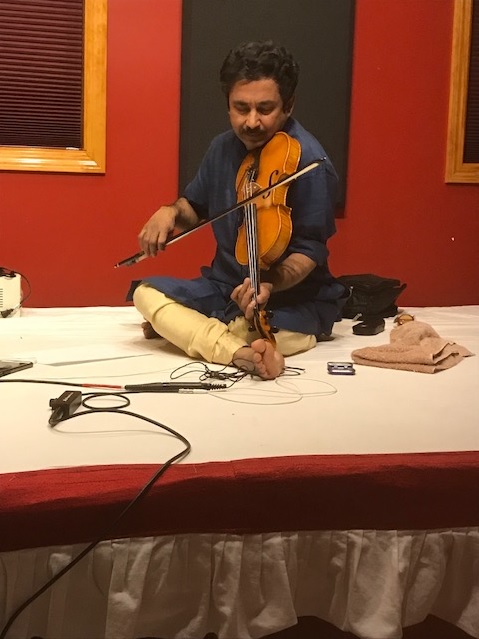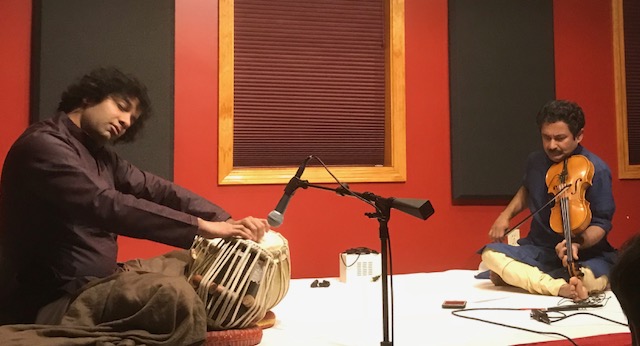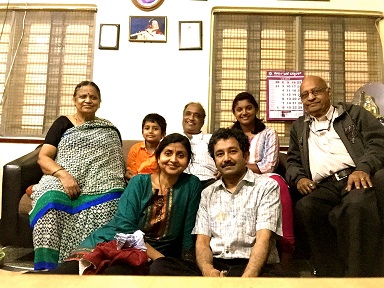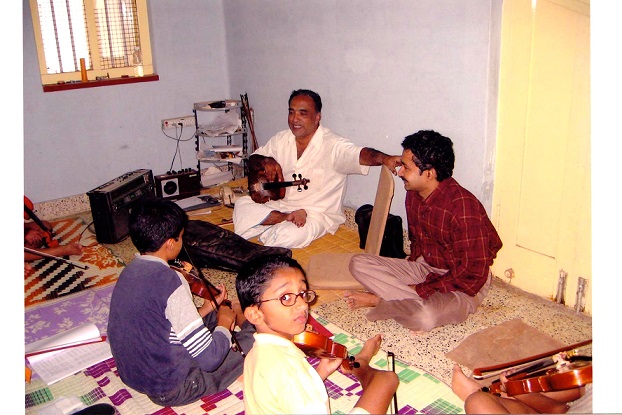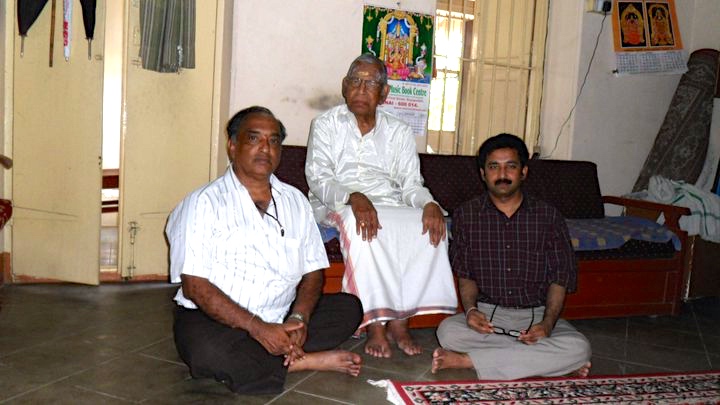Contribute
| In Conversation With Violinist Purnaprajna Bangere |
Shuchita Rao
11/30/2017
Learnquest Baithak presented a violin concert by Sri
Purnaprajna Bangere accompanied by Sri Amit Kavthekar on the tabla, on Friday,
November 17 at Jawed Wahid’s music hall in Framingham, MA. By profession a professor of Mathematics and
Music at the University of Kansas, Sri Bangere has trained extensively in the
art of playing the violin under Sri HK Narsimhamurthy, a direct disciple of Vidwan
Parur Sundaram Iyer and his sons, the legendary violinist Vidwans MS
Gopalakrishnan and MS Ananthraman. Continuing the tradition established by the
Parur school, Sri Bangere played several ragas common to Carnatic and
Hindustani systems such as Abhogi, Hansadhwani, Malkauns, Behag, Bhimpalasi and
Desh. He also introduced a new Carnatic raga “Ranjani†to the audience
consisting largely of Hindustani music lovers. What was unique about Sri
Bangere’s three hour concert was a lecture demonstration on the topic of his
cross-disciplinary research in mathematics and music where he explores how the
Eastern and Western musical systems can be bridged using microtones and African
blues. Sri Amit Kavthekar provided excellent, nuanced accompaniment on the
tabla. Shuchita Rao of Lokvani spoke to Sri Bangere about his
journey in music and mathematics. Q. How did you get
interested in pursuing a career in teaching Mathematics? A. My father, Sri BS
Panduranga Rao was a professor of Mathematics (now retired) who taught at the
University of Mysore. Naturally, I developed a love for mathematics. Q. How about your
love for music. Where does that stem from? A. My mother Sunanda Rao sings beautifully. She wasn’t
formally trained in music until later in life but is gifted and sings in
perfect pitch. My sister is a gifted dancer and also sings beautifully. Music
was in the air in our home since my baby days. It was an integral part of my
childhood. Q. What drew you to
the violin? A. My father provided exposure to Western classical music
recordings played on the violin and also to the music of the legendary
violinists, the late Vidwaan Lalgudi Jayaraman and the late Vidwaan MS
Gopalakrishnan. When I was four years
old, I used to listen to a tape recording of a Violin-Veena-Flute trio in which
Lalgudi Jayaraman played the violin. After presentations of raga Mohana and
Behag thillana, the tape would play a rendition of Raga Shuddha Dhanyasi by Sri
MS Gopalakrishnan (fondly known as MSG). I would say “Oh, this man also is so
great!†I was always struck by the contrasting styles of music played on the
violin. The mere sight of the instrument always evoked deep emotions inside me
and I told my father that I wanted to learn playing it. I knew that it was the
violin and nothing else. He got me a violin when I was a kid; I remember having
it beside me in bed as I slept. I was perhaps afraid someone would take it,
kind of silly, but that was what it was. Q. Can you describe
your early years of musical training? A. I was drawn to music very early in my life. I initially
learned vocal music from T. R. Srinivasan for more than 5 years. Then, Smt.
Sitalakshmi, Smt. Jayamma taught me the elementary steps on the violin. My mind
was always occupied by music. Even if I passed in front of a barber’s shop and
I heard music coming from it, I stopped to listen to it. One of my father’s
friends had an extensive collection of music records mostly of western
violinists. Every other Saturday, I would spend atleast three hours in the
afternoon listening to recorded music in his house for many years. My vocal
music teacher, Sri T.R Srinivasan was a selfless man and a musician. He had
always taken a very keen and proactive interest in my music. He strongly felt
that I should learn from an esteemed teacher and took me to well-known
violinist and teacher, Sri HK Narsimhamurthy, (HKN) who was a senior disciple
of Parur Sundaram Iyer, and his illustrious sons MSG and M. S. Ananthraman.
After listening to my playing, HKN accepted me as a disciple. It was from him
that I learnt for the first time many things that were to become foundation of
my violin playing. He imparted in me the abiding culture of violin practice,
what it takes to learn advanced techniques and the compelling necessity to
strive for perfection. It was a terrific time for me, and I used to literally
hang onto every word uttered by him and take it to heart. Q. Could you describe
your music practice sessions? Were the sessions supervised by your teacher? A. I used to go to my teacher’s house around 6:30 am
(sometimes even earlier), and sit and practice for hours every day in his music
room. He would come after about an hour and a half to teach me. I thought he
would be sleeping. But I found out early that this was an eclectic form of
sleep, if it was such. He would be resting in the adjoining room and would
guide me from there. Even a minute error in pitch or elongation of a note would
catch his attention. He would remark in Kannada “That “Ga†note was longer than
it should have been†from inside his room.
I soon realized that my teacher was not sleeping. Rather, he was
listening very carefully to what I was playing. Soon after that realization, I
began playing for him, knowing I was being musically followed. These are our
great people. It is because of them that the music of India has been preserved.
If I were in his position, I might have preferred not to be bothered early in
the morning and said “I have had a late night. Come at 8:30AM tomorrow.†But, he never said that and appreciated me
when I played right and pointed out mistakes when I made them. There was not
even an iota of feeling in him of “I want my space and peace, let him come at
the time I teach and leave soon.†On the contrary my going early was encouraged
and my intense practice deeply appreciated. I felt egged on, and increased it
even further much to my parents’ alarm. I owe HKN more than I can express; it
was his words and encouragement that made me what I am today, for whatever it
is worth. Q. If practice
sessions went on until 10:30AM, what happened to attending school/college? A. I used to skip the first couple classes in school. In
college, when I pursued pre-university (what we call grades 11 and 12) and
Bachelor’s degree in Science, I skipped classes frequently and concentrated on
music practice. I sometimes dream to
this day of a class I have missed, no knowledge of the syllabus with an exam to
be taken in 3 days! Q. What was the
musical content you worked on in the practice sessions? How many ragas did you
learn from your teacher? A. Initially, I worked on elementary exercises such as
SaRiGaMaGa - - RiGaRiSa…RiGaMaPaMa – GaMaGaRi and so on played from slow to
very high speeds. Then there would be advanced exercises which required
considerable technical skills. I played
them in a plain fashion and then repeated the patterns playing with added
gamakams (heavy oscillations) in several speeds. I was taught different types of bowing and
also playing at different speeds. Once I reached home after school, I practiced
everything once again between 4pm and 8pm. My teacher used to tell us stories
about how MSG practiced and I used to get inspired by them. I must have learned
120 different compositions in more than 40 different ragas from my teacher. My
music books say I was taught even more, over an intense period of 8 years. But
the lessons continued whenever I used to be in Mysore during long breaks for
several years to come. I used to be in HKN’s home for a lot of time those days Q. The musical
exercises that you mention – are they standard exercises taught to all students
of Carnatic music? A. Some of them are common exercises and are said to be
created by the father of Carnatic music, Saint Purandara Dasa. Others are
specific violin exercises practiced by students of the violin school I come
from, the so called Parur school. SaGaPaMa…RiMaNiDhaPaMaGaRe,
RiMaDhaPa…GaPaSaNiDhaPaMaGa etc…we practiced such exercises in melakartha
(parent) ragas such as Kalyani, Todi and Kharaharapriya. In a sense, these
exercises are more complicated than the compositions. To build technical
skills, enormous time was spent on these exercises. I practice them even now. Q. Do you recall any
interesting incident around any of the practice sessions? A. Once, my teacher’s gifted
(and now a leading violinist) son H.N Bhaskar (HNB) and I played a
varnam in raagam Mandaari twenty-five times continuously without letting go in
two speeds, while Bhaskar’s mother Rajalakshmi who is an outstanding vocal
teacher and musician in her own right put thaalam with her hands and kept
rhythm for us. HNB and I used to practice for hours every day and for years
this went on. When I became HKN’s student, he was only 3. I remember him
sitting on his mom’s lap when I went with T. R. Srinivasan for the first time
in 1979 to HKN’s home. Later my teacher’s talented nephew Srinivas and nieces
Smitha and Sindhu also joined us in practice. Those were the days. I have
played in some big venues and may play in bigger venues and such but it is this
emotional, physical and spiritual foundation that was laid by my teacher in
that special music room that has stayed with me and gives me strength to this
day. My teacher has a brilliant mind and is a storehouse of knowledge. He is
selfless, humble and a remarkable man and a musician. This does not even come
close to how I feel inside about him. Q. What about
spontaneous improvisation which is at the heart of Indian classical music? How
did you learn to do that? A. My teacher never encouraged us to memorize stuff. He
never said “I will give you this alaap – you memorize it.†He would show us
some but by and large, it had to come from the student. In order for the skill
of spontaneous improvisation to develop, a student must listen a lot to the
masters. It was at this time that I got into listening to MSG very deeply. I
used to listen to his recordings repeatedly and reproduce the minutest detail
if I could. By practicing line by line, nuance by nuance, one gets an
understanding of the conceptual ideas and an understanding of how a maestro’s mind works. One observes
what is happening, where and how pauses are chosen, the kind of phraseology
that is used, how the raga is developed from the very first note etc. Then, if
one has good technical skills, one can pay attention to the technical aspects
and observe how a maestro does what he does. This is where one’s training and
practice skills come into play. Once you listen to your teacher’s music everyday,
it gets into your system. You then start improvising on your own. It was this
kind of comprehensive training one got. Not everything can be taught by a
teacher. Music is too vast and deep, one has to learn from osmosis. In the end, my teacher taught me how to teach
myself in the long run so as to sustain beyond the direct teaching. This is the
greatest gift he gave his students. He emanates genuine humility that is
indescribable. He has told me a number of times “I have only taught you 2% of
what you knowâ€. I disagree. Without pretense to sound humble, I can say from my
heart, he has given me that crucial heart in every music cell I have, that goes
beyond mere techniques and knowledge of compositions. It takes a great teacher
and a great man to inspire and hook a student to music, especially a critical
minded student. Q. Can you describe
the experience of meeting your idol, the legendary Vidwaan MS Gopalakrishnan in
person? A. I was eight years old when I met MSG for the first time.
He used to visit Mysore often to give concerts. On one such occasion, I
mustered enough courage to go and talk to him. He was in his forties and
majestic looking and bent down to talk to me. He spoke in an unhurried manner
giving me all the respect that is usually given to an adult “Who are you
learning with?†he asked me. He was a musician who never spoke in a patronizing
manner to little kids. This incident has stayed with me for 30-40 years. Whether
young or old, you must treat everyone with the same respect, he told me when I reminded him of this incident 40 years later. Q. What do you find
most appealing about Vidwaan MS Gopalakrishnan’s craft? A. He integrated music of the North and the South. MSG is a
universal musician with a mind so vast that it saw music as a continuum and as
a unified whole. “I am this OR I am that†is given to lesser minds. Legends do
not box themselves in, nor do they judge people in that manner. Some people
criticize MSG for that same reason. Our school’s philosophy is that both the
Carnatic and Hindustani systems have the same roots. We go to those roots to
rejuvenate ourselves. This was essentially the philosophy of Parur Sundaram Iyar, who was MSG’s father, a comprehensive musical
genius. MSG could play pure Carnatic music that a Carnatic puritan wants or
pure Hindustani like a Hindustani puritan wants. There are a number of recording
that are a testimony to this. But he has developed his own signature style and
sound, a truly universal musician. One of India’s greatest! Q. While Carnatic and
Hindustani systems have the same root, how would you say they differ? A. The answer depends
on who you ask. I feel that the microtones and the phraseology, and the general
approaches are different. This is a deep
topic and requires longer discussion. But while there are differences, there
are also structural similarities and unity in the diversity. It is always nice
to think of Indian classical music as a gigantic tree with several branches
than to keep concentrating on a particular branch and claim that it alone is
the way of doing music. Great musicians are given to see a unified picture of
music, the Indian classical music. Q. Have you managed
to tie your knowledge of mathematics to music? A. I used to listen constantly to how MSG would move close
to the boundaries of the raga’s grammar and the two systems of music. He worked
on the Northern and Southern systems of music in India. My mind always used to
delve on this aspect of MSG, the vast universal mind free from dichotomies. One
naturally thought of extending the boundaries. The integration of Western
classical, Jazz and Blues where key changes, polyphony and counterpoint are the
main features with Indian classical music. The mathematical framework developed
by Alexander Grothendick, one of our greatest mathematicians who has re-written
the foundations of algebraic geometry developed new way of looking at geometric
objects. This opened up vast new territories that were previously inaccessible
for systematic study. One of those crucial points of view is what I have
incorporated into my work on the integration of music of various genres. This
Meta mathematical framework that we have developed allows one to expand the
notion of the classical raga. The compositions based on the framework allow
western music elements to enter in a natural way. Q. You have formed a
musical quartet in Kansas City. Can you tell us about the kinds of music the
quartet composes and plays? A. I have been
working with the two time Grammy award winner, the Western violinist David
Balakrishnan who is one of the foremost Jazz and classical crossover composers
in the United States. He is not from Kansas , he lives in Berkeley,
California. He is director of the highly
regarded music group Turtle Island String Quartet., which has been nominated
for 7 Grammys under his direction. Balakrishnan, Kansas based world class bass
player Jeff Harshbarger, the highly talented percussionist Amit Kavthekar (last
disciple of Ustad Alla Rakha) are part of the quartet. Sometimes the players
change. So it is more an ensemble. David has named it “Purnaloka
ensembleâ€. It must be insisted that this
name was NOT due to me. This was given by David Balakrishnan. Part of the quartet’s name comes from a pun;
my name (Purna) since David feels I am the force behind it, and the word “lokaâ€
is because we are taking up not one raga but a whole family of stuff, which
goes under the name “meta raga system†coming from the framework. We have
recorded one piece (named “Syzygy†by David) and are working on the second
piece which is a violin concerto consisting of three movements. Q. How many hours do
you sleep in a day and for how many hours do you practice music every day? A. I sleep for about 4-5 hours a day but I take two short
ten minute naps in the afternoon. I
usually practice for about three hours a day but around concerts, I may
practice for about 5 hours a day. My wife Sunita, who is a professor of
Accounting at Washburn University in Topeka says that I am playing violin all
the time (which is not true!). Q. You have a young
son. Does he play the violin? A. Yes. My son Ishaan is seven years old and is learning to
play the violin in both the Western and Indian Classical styles. I teach him to
play Indian classical music, when he prefers to listen to me.
You may also access this article through our web-site http://www.lokvani.com/
